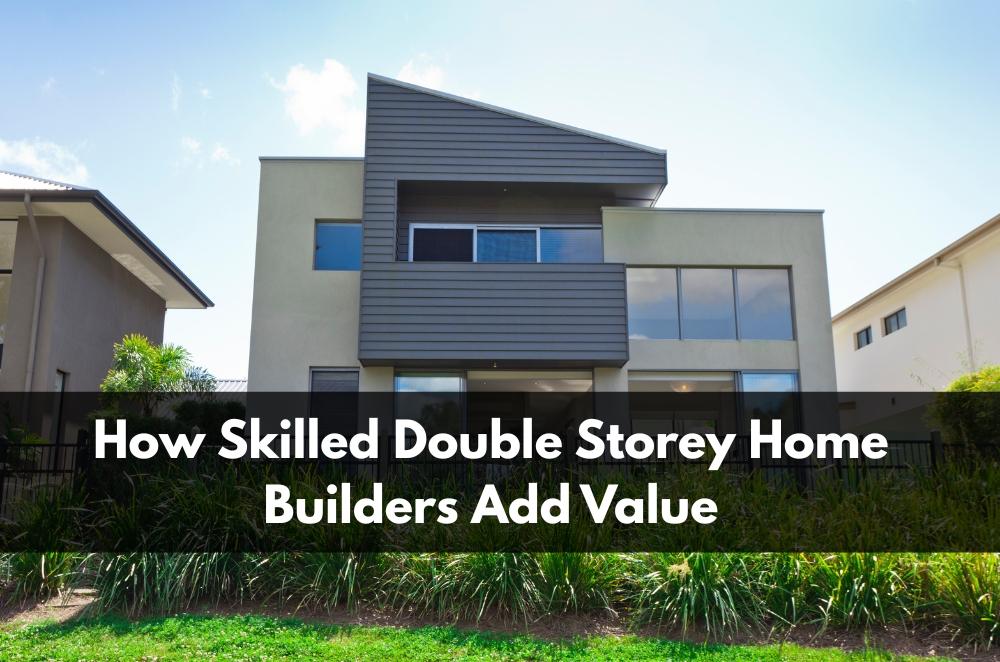How Skilled Double Storey Home Builders Add Value

Big builds feel exciting—until the decisions stack up. Plans, soil tests, quotes, contracts. It’s a lot. The best way to stay calm is to vet methodically: define what you need, check evidence, and keep the numbers honest. In that context, reviewing portfolios from double storey home builders Sydney homeowners rely on can be useful, so long as you’re comparing scope, structure, and aftercare on equal footing. The aim here isn’t to chase the lowest price; it’s to choose a crew that will protect your budget, your block, and your weekends.
Know your brief before you get quotes
A precise brief turns guesswork into numbers you can compare. Two sentences—what you want and what you can spend—set the rails for every conversation that follows.
-
Scope clarity: Describe rooms, storage, and outdoor links so the design matches how you’ll live, not just how it looks on paper.
-
Site realities: Note slope, drainage, access width, and neighbouring overlooks so solutions are practical and compliant.
-
Performance targets: Specify insulation, glazing, and ventilation goals to avoid cost blowouts on energy later.
-
Budget envelope: State a realistic range, including contingency, so selections don’t wander into wish-list land.
A tight brief also makes it easier to spot when a quote omits something important—like excavation, temporary services, or waste removal—that would reappear later as a variation.
Assess structure and site risks early
The bones of a double-storey are doing real work. Understanding how they carry load and resist wind shapes both safety and cost. A few checks up front keep surprises small.
-
Soil conditions: Ask for geotech investigations so footings, piers, and slab design match the ground beneath, not a template.
-
Load paths: Confirm how upper-floor loads transfer to the ground without overstressing mid-level spans or creating bounce.
-
Water management: Plan roof falls, overflows, and ground drainage so storms don’t find the weakest detail.
-
Neighbour impacts: Consider privacy screens, overshadowing, and noise; early solutions keep goodwill and reduce redesigns.
I once walked a block with a builder who carried a simple level and a tape. Ten quiet minutes mapping falls and access saved weeks of redesign and a pile of avoidable costs.
Understand approvals and codes (no surprises)
Paperwork isn’t glamorous, but it’s where time is won or lost. Approvals, pathways, and technical notes all sit inside a framework you can use to your advantage. When comparing proposals, see who speaks calmly about compliance and offers a tidy sequence for lodgement and inspections. Reference to the housing code helps anchor the process in rules rather than assumptions.
-
Pathway choice: Confirm whether your design fits a complying pathway or needs a full development application, and what that means for timing.
-
Inspection rhythm: Map the inspection points—footings, frame, waterproofing—so the schedule accounts for sign-offs.
-
Detailing standards: Check fire separation, stair geometry, balustrade heights, and waterproofing details against code notes.
-
Documentation quality: Look for coordinated plans and engineering that align; mismatches here are the seed of late variations.
The right team treats codes as a given, not an obstacle. That mindset keeps momentum steady and the build cleaner from slab to ridge.
Compare value beyond the headline quote
A number on a page isn’t the whole story. You want to know what sits underneath: supervision, sequencing, and how trades are coordinated when weather turns or supply chains wobble.
-
Inclusions inventory: Line by line, confirm excavation, temporary services, scaffolding, and waste so totals reflect reality.
-
Program logic: Ask how the schedule absorbs rain days and inspection windows without cascading delays.
-
Change control: Look for a clear variation process with unit rates and approval steps to keep scope honest.
-
Proof of delivery: Seek recent examples with similar constraints—tight access, coastal winds, awkward soils—so experience maps to your site.
Comparative constraints noted by duplex builders in Sydney—shared services, acoustic separation, and boundary fire detailing—often mirror challenges in detached double-storey builds and can inform specification checks without changing your chosen form.
Materials, detailing, and durability
Finishes are the face; detailing is the backbone. Get the hidden stuff right and the home feels solid, quiet, and easy to heat or cool.
-
Envelope choices: Balance cladding, sarking, and insulation to suit the microclimate rather than generic specs.
-
Wet areas: Prioritise membranes, fall to waste, and junction detailing—small misses here create big headaches later.
-
Acoustics: Treat floor build-ups, underlay, and door seals as comfort features, not luxuries, especially over bedrooms.
-
Maintenance plan: Ask for care schedules and product datasheets so future upkeep is predictable.
The best builds age gracefully because the details are simple to inspect and simple to maintain. That’s design kindness—paid forward to your future self.
Supervision, communication, and neat handovers
How a site is run is how a build feels. Calm schedules, clean edges, and tidy handovers aren’t accidents; they’re the product of process.
-
Single point of contact: Confirm who owns decisions day to day and how often you’ll get updates.
-
Issue logs: Insist on a living list of defects and decisions so nothing hides in emails.
-
Trade coordination: Ask how clashes are resolved—roofers, sparkies, and plumbers stepping through without rework.
-
Handover pack: Expect manuals, warranties, and as-builts that match the house you’re standing in.
On one project, a weekly 15-minute site walk avoided a month of rework. Small, consistent rhythms beat frantic end-of-build sprints every time.
Checklists and staged reviews (keep it simple)
You don’t need to be an expert to run a sensible review. Think checklists at milestones and photos for record-keeping. A practical tool here is a double storey building checklist used as a prompt—adapted to your plan, your site, your weather.
-
Milestone checks: Walk the slab, the frame, and the pre-linings to catch issues while fixes are cheap.
-
Photo evidence: Date-stamped images of flashing, cavity trays, and waterproofing become gold if questions arise later.
-
Weather watch: After heavy rain, re-check drainage paths and temporary protection before lining goes on.
-
Defect closure: Close items in writing with photos attached; clarity now prevents friction at handover.
Simple tools create calm. When everyone can see what “done” looks like, you spend less time arguing and more time building.
Choosing with confidence
In the end, vetting isn’t a mystery; it’s a rhythm. Start with a clear brief. Walk the site with eyes open. Treat codes as rails, not roadblocks. Compare value by the bones of a proposal—structure, sequencing, and supervision—rather than the gloss of renderings. A builder who talks calmly about inspections, shares tidy documentation, and logs decisions in the open will likely deliver the same clarity on site. I’ve learned to keep a small notebook: soil notes, fall directions, and a list of non-negotiables. It keeps me honest when the shiny stuff tempts shortcuts. If your short-list includes double-storey home builders in Sydney, weigh them by how they plan, not just how they pitch. Good builds feel boring in the best way—quiet progress, small adjustments, and handovers that just work. That’s the kind of boring that lets you enjoy the extra space upstairs without worrying about what’s behind the walls.







